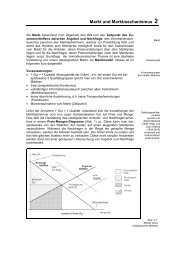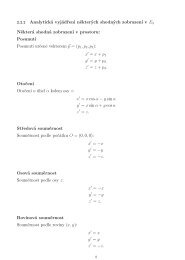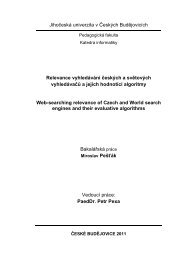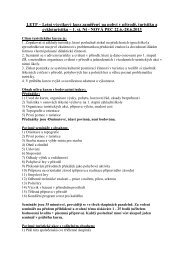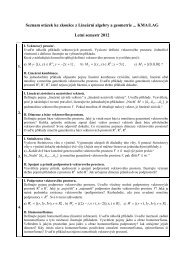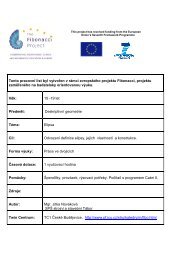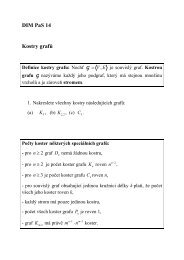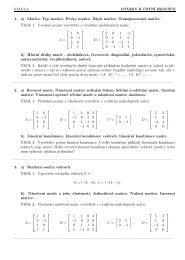INSTRUCTIONS FOR THE AUTHORSOF THE ARTICLESSTUDIA KINANTHROPOLOGICAScientific Journal for Kinanthropology is mainly aplace for publishing reports of empirical studies,review articles, or theoretical articles. Articles arepublished in Czech, Slovak, and/or Englishlanguage. The author (senior author) is responsiblefor special and formal part of the article. All textsare subject to review process and assessed by atleast two expert referees. The review procedure isauthorless. Board of editors decide about article´spublishing having regard to scientific importanceand review process.Most journal articles published in kinanthropologyare reports of empirical studies, and therefore thenext section emphasizes their preparation.Parts of a Manuscript1. Title Page consists of(a) Title. A title should summarize the main ideaof the paper simply and, if possible, with style.It should be a concise statement of the maintopic and should identify the actual variables ortheoretical issues under investigation and therelation between them. The recommendatedlength for a title is 8 to 10 words. A title shouldbe fully explanatory when standing alone.(b) Author´s name and affiliation2. (a) Abstract (p. 2). An abstract is brief,comprehensive summary of the contents of thearticle. A good abstract is accurate, selfcontained,concise and specific, nonevaluative,coherent and readable. An abstract of a reportof an empirical study should describe in 150 to200 words• the problem under investigation, in onesentence if possible;• the subjects, specifying pertinent characteristics,such as number, type, age, sex, andspecies;• the experimental method, including theapparatus, data-gathering, and complete testnames, etc.• the findings, including statistical significantlevels, and• the conclusions, and the implications orapplications.(b) Key words (p. 2), not more than 5.Introduction (p. 3). The body the paper body of apaper opens with an introduction that presents thespecific problem under study and describes theresearch strategy. Definition of variables andformal statement of your hypotheses give clarity.Because the introduction is clearly identified by itsposition in article, it is not labeled.3. Method. The Method section describes indetail how the study was conducted. Such adescription enables the reader to evaluate theappropriateness of your method and thereliability and the validity of your results. Italso permits experienced investigators toreplicate the study if they so desire. Methodsection is devided into labeled subsections.These usually include description of subject,the apparatus (measures or materials), and theprocedure. If the design of the experiment iscomplex or the stimuli require detaileddescription, additional subsections or subheadingsto devide the subsections may bewaranted to help readers find specific information,include in this subsections only theinformation essential to comprehend andreplicate the study. Given insufficient detail,the reader is left with questions, given to muchdetail, the reader is burneded with irrelevantinformation. Method section is usually devidedinto: Subject; Measures (Apparatus orMaterials) and Procedure.4. Results. This section summarizes the datacollected and the statistical treatment of them.First, briefly state the main results or findings.Then report the data in sufficient detail tojustify the conclusions. Mention all relevantresults, including those that run counter thehypothesis. Do not include individual scores orraw data, with the exception, e. g. of singlesubjectdesigns or illustrative samples.Tables and figures. To report data, choose themedium that presents them clearly andeconomically. Tables provide exact values and canefficiently illustrate main effects. Figures ofprofessional quality attract the reader´s eye and bestillustrate interactions and general comparisons.Although summarizing the results and the analysisin tables or figures may be helpful, avoid repeatingthe same data in several places and using tables fordata that can be easily presented in the text. Referto all tables as tables, and to all graphs, pictures, ordrawings as figures. Tables and figures supplementedthe text; they cannot do the entire job ofcommunication. Always tell the reader what to lookfor in tables and figures and provide sufficientexplanation to make them readily intelligible.5. Discussion. After presenting the results, youare in a position to evaluate and interpret theirimplications, especially with respect to examine,interpret, and qualify the results, as wellas to draw inferences from them. Emphasizeany theoretical consequences of the results andthe validity of your conclusions. When thediscussion is relatively brief and straigh-148
tforward, some authors prefere to combine itwith the previous Result section, yieldingResults and Conclusion or Results andDiscussion).Conclusion part contrary to Abstract is notobligatory. This part could also be in sectionResults and Conclusions.6. References. Just as data in the paper supportinterpretations and conclusions, so referencecitation document statements made about theliterature. All citations in the ms. must appearin the reference list, and all references must becited in text. Choose refferences judiciouslyand cite them accuratly. The standard procedurfor citations ensure that refferences areaccurate, complete, and useful to investigatorsand readers. In references section follow theAPA-Publication Manual (6 th edition, 2010).7. Appendix is although seldom used, is helpful ifthe detailed description of certain material isdistracting in, or inappropriate to the body ofthis paper. Some examples of material suitablefor an appendix are (a) new computer programspecifically designed for your research andunvalaible elsewhere, (b) an unpublished testand its validation, (c) a completed mathematicalproof, (d) list of stimulus material (e. g.those used in psycholinguistic research), or (e)detailed description of a complexe piece ofequipment. Include an appendix only if it helpsreaders to understand, evaluate, or replicate thestudy.Author´s address (contact address) – the authorpresents his/her address and address of his/her coworkersas the last information in the article.He/she presents family name, first name, degrees,complete address, City Code, telephon number andmainly e-mail.Dimensions of the tables (including title) can´t beover width and height of the page limited by abovementioned page´s appearence. The name of theTable and all languages, in English and in Czech, itis possible to use English text in the Table and thelist of Czech translations is presented under thetable (or contrary).Figures (graphs, pictures, drawings, etc.) areregularly sheets in the quality replying to therequirements of the sample for print. The Figure´sdimension including all descriptions can´t be biggerthan above mentioned page´s dimension. The nameof figure and all descriptions used in figure are alsoin 2 languages – in English and Czech.To the authors, whose articles are connected withthe project of some Grant Agency, is recommendedto emphasize this fact (i. e. name of the project andits number).The autors mail the manuscripts in 1 copy togetherwith disc to the address of journal editor office (orto the hands of journal´s presented editor):Please note: From January 2011 there will be ahandling fee of 500 Kč (or 20 €) for articlesaccepted by <strong>Studia</strong> Kinantropologica, Accountnumber: 104725778/0300, Specific symbol: 1214,IBAN: CZ20 0300 0000 0001 0472 5778, SWIFT(BIC) CEKOCZPP. In a message for the recipientto enclose the name of the first of the author.e-mail: studiakin@pf.jcu.czwww.pf.jcu.czTechnical form of (hand) writingArticles are basically accepted in the form of texteditor, Microsoft Word or by editoring, keepingfollowing setting and arrangements:- form A4- all outsides 2.5 cm- size of letters 11, for the name of work a 10 forthe other text,- single lines,- letters Times New Roman CE,- distance from the first line of the column – 0.5cm- gaps behind the headlines – 6 points- all headlines extra bald and situated in thecentre, Tables can be presented direct in themanuscript or mostly are presented assupplement enclosures of the article.149
- Page 1:
Universitas Bohemiae MeridionalisBu
- Page 4 and 5:
OBSAHVýzkumné studieJ. BĚLKA, K.
- Page 6:
VÝZKUMNÉ STUDIERESEARCH STUDIES66
- Page 9 and 10:
(Matthew, & Delextrat, 2009), ragby
- Page 11 and 12:
vzdálenosti (ɳ 2 =.0156). Výsled
- Page 13 and 14:
LiteraturaBarbero-Alvarez, J. C., S
- Page 15 and 16:
několika desítek tisíc. Otázkou
- Page 17 and 18:
vykazovány inaktivity. Doba stráv
- Page 19 and 20:
práce, Univerzita Karlova, Fakulta
- Page 21 and 22:
(1997, 1998), Subramanian - Silverm
- Page 23 and 24:
To znamená prijatie, alebo zamietn
- Page 25 and 26:
• Na vidieckych ZŠ chlapci (71,1
- Page 27 and 28:
ako polovica samotných učiteľov
- Page 29 and 30:
LiteratúraAntala, B. (2009). Teles
- Page 31 and 32:
Šikula, T. (1992). Názory a posto
- Page 33 and 34:
poznat sebe sám, a má-li protivn
- Page 35 and 36:
2) Dalším předpokladem bylo, že
- Page 37 and 38: v sebevědomí? - Pokud ano, je ví
- Page 39 and 40: převažovaly do značné míry sou
- Page 41 and 42: Studia Kinanthropologica, XIII, 201
- Page 43 and 44: neparametrický Man-Whitney test. D
- Page 45 and 46: Beam, W. C., & Merill, T. L. (1994)
- Page 47 and 48: 107
- Page 49 and 50: jednom až dvou úsecích, jejichž
- Page 51 and 52: úseky od 1 do 4 km opakoval někol
- Page 53 and 54: Podle něj se běžci při tomto kv
- Page 55 and 56: se připouští déletrvající odp
- Page 57 and 58: lostním, poněkud zekonomizovaným
- Page 59 and 60: délky intervalů vzhledem k délce
- Page 61 and 62: Tabulka 16. Vývoj světového reko
- Page 63 and 64: Tabulka 18. Medailisté na olympijs
- Page 65 and 66: Choutka, M., Dovalil, J. (1991). Sp
- Page 67 and 68: ÚvodČinnost podpůrně pohybovéh
- Page 69 and 70: jelikož podle JANDY (1982) schopno
- Page 71 and 72: cvičení…), abychom předcházel
- Page 73 and 74: k systematické péči o optimáln
- Page 75 and 76: PŘEHLEDOVÉ STUDIEREVIEW STUDIES13
- Page 77 and 78: Studia Kinanthropologica, XIII, 201
- Page 79 and 80: sehráno již v únoru na krakovsk
- Page 81 and 82: 11:14. Ve druhé půli však došlo
- Page 83 and 84: Obrázek 6. Sport na střeše Palá
- Page 85 and 86: STUDIA KINANTROPOLOGIAVědecký ča
- Page 87: Technická úprava rukopisuPřísp
- Page 91: UpozorněníPočínaje rokem 2011 b



